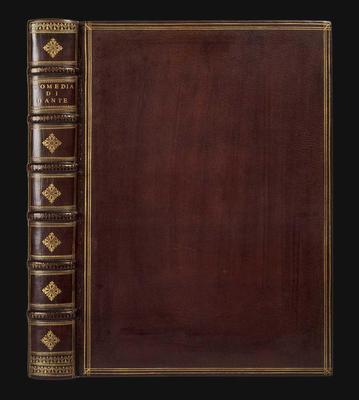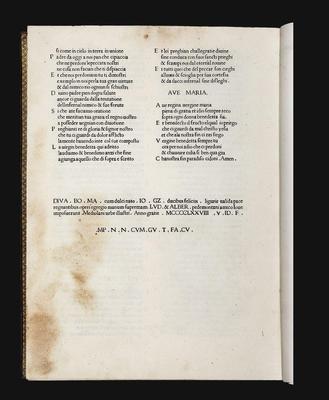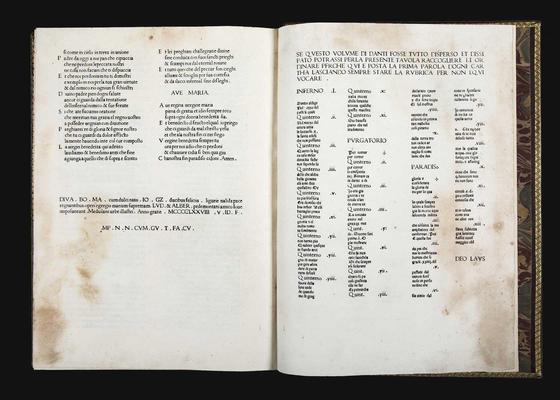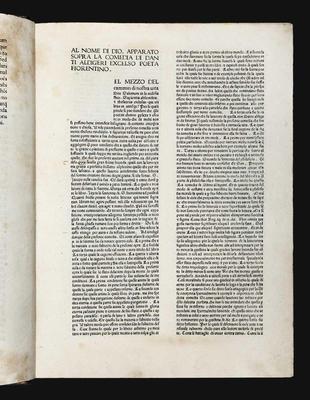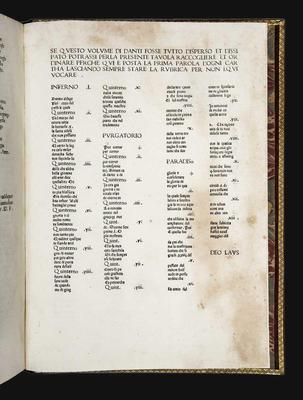Dante Alighieri
Divo Guilielmo Marchioni Montisferrati... Martinus Paulus Nidobeatus Novariensis P.F.D. Dantis aldigerii clarissimi poetae fiorentini comediam cum nuper accepissem in manus.
Milan, Ludovicus and Albertus Pedemontani, for Guido Terzagus, 27 September 1477 - 1 March 1478.Three parts in one volume in folio (336x243 mm). Collation: [a6, b10, c-e8, f-g6, h-k8, l6; a4, b-c8, d-e6, f-i8, k10; a-f8, g-h6, i8, k-m6, n8]. [82], [74], [94] leaves. Complete, including the fol.1a6 blank. Text in one column, 47-48 lines, surrounded by the commentary, 66 lines. Type: 1:83G (commentary), 2:115R (text). Colophon at the end of each cantica, on fols. l6v,2k10v and n8v. Blank spaces for capitals, mostly with printed guide letters. The first capital letter of every terzina set out. Early twentieth-century gilt-tooled granata morocco, boards framed within gilt fillets. Spine with six raised bands, compartments gilt-tooled with floral motifs, title in gilt lettering. Gilt board edges, marbled pastedowns and flyleaves, inside dentelles. Gilt and gauffered edges. A fine widemargined copy, skilfully washed. The first and last leaves slightly browned.
Provenance: Livio Ambrogio collection.
The famous and rare Commedia Nidobeatina, so called after the name of its editor, the humanist and courtier at the Sforza court Martino Paolo Nibia from Novara, more commonly known as Nidobeato.This Milanese edition of the Commedia is mainly based on the text edited by Colombino Veronese for the editio princeps Mantuana of 1472.The commentary surrounding Dante's terzine is the one by the Bolognese Iacomo della Lana, but Nidobeato made such a large number of changes, added so many biblical passages, quotations from classical sources, and allusions to contemporary history that it would not be wrong to affirm that the result represents the first fifteenth-century printed commentary, in other words the first modern commento written specifically for a printed edition.The initiative was financed by another nobleman active in the Sforza court, Guido da Terzago, who on 9 June 1477 drew up a contract for the printing of the edition with Ludovico and Alberto Piemontesi. The Milanese Commedia is the only book known to contain the name of both printers. The preliminary six-leaf quire would appear to have been the last part of the text to be printed, and contains Nidobeato's prefatory letter dated 1 March 1478 to his former pupil with ambitions to become a humanist Gugliemo Marquis of Monferrat, together with the first edition of the prologue Dante poeta sovrano, a summary of the Expositiones by the Carmelite Guido da Pisa. The Nidobeatina edition was very influential in promoting, especially in northern Italy, the new vernacular literature; it has always been highly praised for its harmonious mise-en-page, with a fine balance between the text of the poem in roman font and the surrounding commentary, printed in a smaller but very legible gothic type. Despite the success of the Nidobeatina the Commediawould not be printed again in Milan for more than three centuries.This edition is celebrated for two curious peculiarities found at the end. The third colophon ends with a long acrostic – .MP.N.N.CVM.GV.T.FA.CV.– which reveals in cryptic form the names of the editor Paolo Beato Nibia and his munificent patron Guido da Terzago. On the following page a meticulous table is printed, which indicates the first word of each quire, as a guide to the correct binding of the volume. This feature clearly reflects the contemporary practice of selling books in unbound quires, which made it necessary to give precise and comprehensible instructions for binders and owners, “se questo volume di Dante fosse tutto disperso e dissipato” (i.e “in the eventuality the separate parts of this volume become dispersed”).


